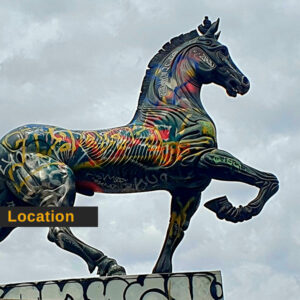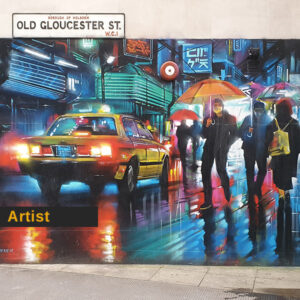The Motivations Behind Street Artists

Street art is a global phenomenon that intertwines personal expression, visual language, creative freedom, political protest, and urban presence. But behind every artwork on a wall, sidewalk, or fence stands a person – sometimes young, sometimes experienced, sometimes famous, and sometimes completely anonymous. What they all share is a deep drive to create, to influence, and to make their voices heard. This chapter explores the motivations and forces driving street artists: Why do they do what they do? What compels them to act, sometimes at personal risk, to leave their mark on public space?
In the past, street artists often hid behind cryptic nicknames or hard-to-decipher signatures. Today, many proudly sign their real names, Instagram handles, or even website addresses. This shift in self-perception reflects a broader change. Behind the spray cans, stencils, and prints lies a complex story of motivations – art that enriches the community and the risks that constrain artistic expression.
Just like digital influencers and online content creators who operate outside of ethical oversight, regulation, or journalistic scrutiny, street artists create popular, sometimes newsworthy content that influences millions. They use city walls as platforms for personal branding and impact, aiming to deliver a message (influence), tell a story (create resonance), and build loyalty (gain followers). Like internet personalities, street artists often operate outside institutional frameworks and gatekeepers.
Street art has the power to bridge divides, transcend language and cultural barriers, and leave a lasting imprint on the collective memory of a city. It serves as a catalyst for social change, shedding light on critical social issues and amplifying the voices of the unheard.
Self-Expression
The most fundamental motivation for many street artists is the need to express themselves. The street is the largest stage – open to all. Unlike galleries and museums, which require connections, resources, or institutional approval, the street offers immediate, unrestricted art. Many artists feel they don’t belong within traditional art frameworks, so they turn to the wall to speak their truth.
Coming from marginalized neighborhoods or communities without representation – or simply feeling invisible – these artists use art to claim presence. They become individuals with names, styles, and messages. For them, painting is an act of personal redemption and a way to survive in a world that doesn’t always listen.

Social Commentary
Many street artists use their work to respond to social and political issues. Street art has a rich history as a tool for activism and as a way to challenge dominant narratives and power structures. Topics like inequality, consumerism, capitalism, and police brutality often appear in their work. It offers a platform for marginalized voices and serves as a vehicle for resistance and societal change.

Fame and Recognition
With the rise of social media, street art has gone global. A small mural in a residential neighborhood can go viral and turn an anonymous artist into a public figure. The visibility of street art—the fact that it’s outdoors and constantly photographed—turns each piece into an opportunity for exposure. Many start with rebellious graffiti and are later invited to exhibitions or commissioned projects. Even anonymous artists build brand recognition through pseudonyms, symbols, or recognizable styles.
Community Building
Contrary to the romantic image of the lone artist, many street art scenes are deeply communal. Whether through graffiti crews, community projects, or informal collaborations, street art fosters a sense of belonging. Artists often speak to and create for their neighborhoods, responding to local events and engaging directly with passersby.
Street art enhances a city’s cultural richness and can transform neighborhoods—sometimes even sparking gentrification. It brings people together through both the act of creation and the conversations it provokes.

Challenging Norms
Street art is inherently subversive. Many artists work without permission, often at night, risking fines, arrest, or having their work erased within hours. Yet this illegal nature can be empowering—reclaiming control and asserting existence.
These artists see their work as a form of resistance—to political systems, capitalist economies, consumer culture, racism, or environmental injustice. The wall becomes a stage for anger, hope, and alternative visions. Their message: silence is not an option. The street is where things must be said.
Liberation, Adventure, and Personal Therapy
Beyond public or political motivations, many artists describe their creative act as deeply personal – an escape, a release, a form of therapy. They don’t always do it for the audience; they do it for themselves. The act of painting, especially in the quiet hours of the night, becomes a ritual of emotional cleansing.
Some artists are driven simply by exploration and play. For them, street art is an open laboratory – a place for experimentation and improvisation. The street is a living, ever-changing environment. One painting might last years, another might be gone in hours. But the process itself – the freedom and spontaneity – is the reward.
Street artists operate within the urban playground, driven by burning personal and social motives. They breathe life into neglected corners, inject color and joy into the cityscape, and challenge us through concrete and paint. Every mural tells a story – and every story reminds us that the city is, above all, a space for people.






















